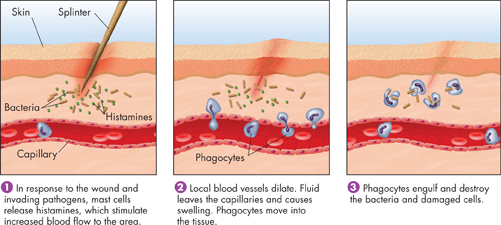
FIGURE 35–5 Inflammatory Response The inflammatory response is a nonspecific defense reaction to tissue damage caused by injury or infection. When pathogens enter the body, phagocytes move into the area and engulf the pathogens. Infer What part of the inflammatory response leads to redness around a wounded area?
d▸ Interferons When viruses infect body cells, certain host cells produce proteins that inhibit synthesis of viral proteins. Scientists named these proteins interferons because they “interfere” with viral growth. By slowing down the production of new viruses, interferons “buy time” for specific immune defenses to respond and fight the infection.
▸ Fever The immune system also releases chemicals that increase body temperature, producing a fever. Increased body temperature may slow down or stop the growth of some pathogens. Higher body temperature also speeds up several parts of the immune response.
 In Your Notebook Develop an analogy that compares the body's nonspecific defenses to a large building's security system.
In Your Notebook Develop an analogy that compares the body's nonspecific defenses to a large building's security system.
Specific Defenses: The Immune System
 What is the function of the immune system's specific defenses?
What is the function of the immune system's specific defenses?
The main function of the immune system's specific defenses is easy to describe but complex to explain.  The immune system's specific defenses distinguish between “self” and “other,” and they inactivate or kill any foreign substance or cell that enters the body. Unlike the nonspecific defenses, which respond to the general threat of infection, specific defenses respond to a particular pathogen.
The immune system's specific defenses distinguish between “self” and “other,” and they inactivate or kill any foreign substance or cell that enters the body. Unlike the nonspecific defenses, which respond to the general threat of infection, specific defenses respond to a particular pathogen.
Recognizing “Self” A healthy immune system recognizes all cells and proteins that belong in the body, and treats these cells and proteins as “self.” It recognizes chemical markers that act like a secret password that says, “I belong here. Don't attack me!” Because genes program the passwords, no two individuals—except identical twins—ever use the same one. This ability to recognize “self” is essential, because the immune system controls powerful cellular and chemical weapons that could cause problems if turned against the body's own cells.
Table of Contents
- Formulas and Equations
- Applying Formulas and Equations
- Mean, Median, and Mode
- Estimation
- Using Measurements in Calculations
- Effects of Measurement Errors
- Accuracy
- Precision
- Comparing Accuracy and Precision
- Significant Figures
- Calculating With Significant Figures
- Scientific Notation
- Calculating With Scientific Notation
- Dimensional Analysis
- Applying Dimensional Analysis




